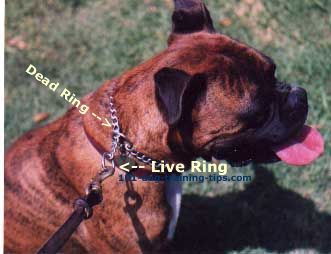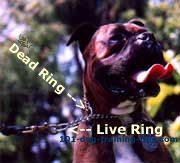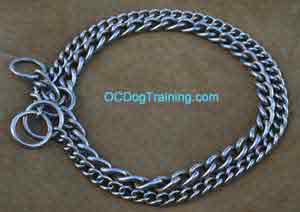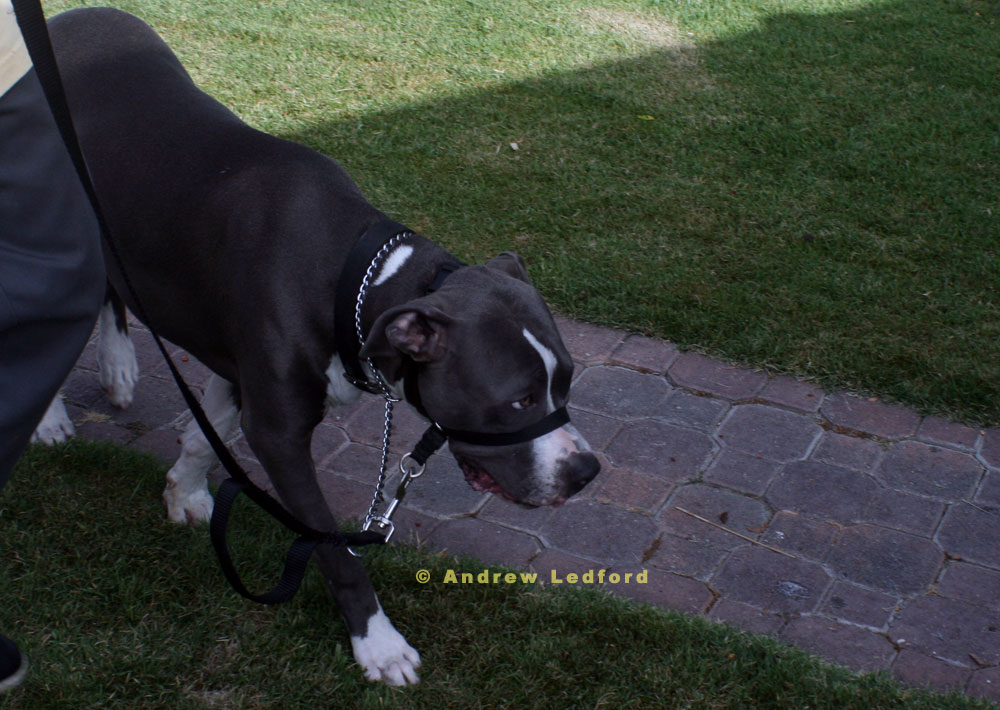Dog Training Slip Collars or Correction Collar
How To Use A Dog Training Slip Collar By Andrew Ledford
714-827-4058
Dog training collars
How to put on, fit, and use dog training slip collars. The dog training collars I’ll be discussing in this article are slip collars. In this day and age of zealot like all positive reinforcement training, using a slip or correction collar can be somewhat controversial. However, slip collars and their variations are safe if used properly. In fact they’re one of the safest collars you can use. The reason is, dogs have a very difficult time escaping from this equipment. Even when a dog panics because something frightens it. They also increase handler, trainer, and public safety when working with aggressive dogs.

Dog training collars are made usable by dropping the chain through one of the rings.
Dog training choke collars or choke chains go by many names, most of which are more appropriate to the collars true function, such as:
- Training collar
- Correction collar
- Slip collar
Dog training slip collars are one of the most popular and most commonly used tools to teach dog obedience commands and leash manners.
There are a few things that’ll make using your collar more effective. These are:
- How the slip collar fits; the proper fit makes it safer and easier to use.
- How the training collar is put on. There is a right way and a wrong way.
- How the collar is used. It should be used as a sharp reminder or as a guide, it should not be used with constant heavy pressure, such as to choke the dog.
- Weight of the chain and/or size of the links.
- Collar placement on the dog.
- Other collars the dog may be wearing.
Training collars work best when fitted properly.
The training collar is the ideal size if it fits snugly, but comfortably over the dog’s head. You don’t want it too tight, but you don’t want it too loose either. If it is too tight, it will be difficult to take off and put on. If it’s too loose it may accidentally slip off the dog’s head when the head is lowered. This can happen when the dog lowers its head to sniff the ground. A collar that is too long for a dog also requires a much more skill to use than a properly fitting collar. Although an ideal fit is nice, it’s not necessary for the collar to work effectively. If you are new to using a correction collar or your timing is slightly off you should use a properly fitting collar.
Collar sizing and measuring your dog.
I usually recommend measuring your dog’s neck with a string or tape measure and adding 2 to 3 inches. Chain slip collars increase in size by 2 inch increments. Slip collars are measured by the length of material between the rings at each end. The collar length may not be exact because of how the links in the chain are made.
Putting the collar on correctly.

When putting the collar on, the part of the chain connected to the live ring (the ring the leash is connected to) should be on top of the dog’s neck. With the collar put on this way – as soon as the leash is made loose the collar releases or relaxes. Correction collars work by making the collar tight then loose in a quick, snappy manner. Making the collar tight is the first half of the correction; making it loose again is the second half of making a correction. The correction should be done as one event, not tight pause then loose.
Choke collar on the wrong way.

If the live part of the collar goes under the dog’s neck, the collar can be made tight, but it will not release back to a loose condition. This constant pressure on the neck elicits a counter pressure response. Most dogs will learn to strain and pull into the leash if they feel this constant pressure around their neck
German training collars will not break easily, like many collars from less developed countries. Quality control issues can also be a problem with collars from China. There have been many changes in quality and manufacturing locations since I first wrote this article.

If you have an aggressive dog or one that runs off you need to use a well-made collar.

So far I have never had a dog injured or run off due to collar breakage; however the risk for harm to a dog is greatly increased with collars that are prone to break.
If your dog’s collar breaks, remember not to panic. Usually when a dog breaks a collar, it’ll momentarily be unaware of its ability to run off. You will be most successful at controlling your pet if you act as though the leash is still connected. Have a calm attitude but get the dog quickly.
A good way to secure a loose dog is to make a slip lead by running the snap of the leash through the handle and slipping this over the dog’s head.
Call 714-827-4058 today to get more information about my in-home dog training programs.
We provide training services to all of Orange County, Long Beach, and the San Gabriel Valley. I do offer convenient customized In home training to a large portion of Southern California’s most dog friendly communities.
Andrew Ledford
714-827-4058
The Dog Training Leash
